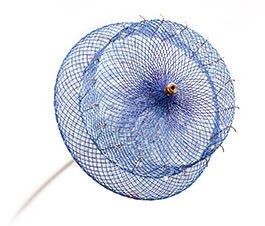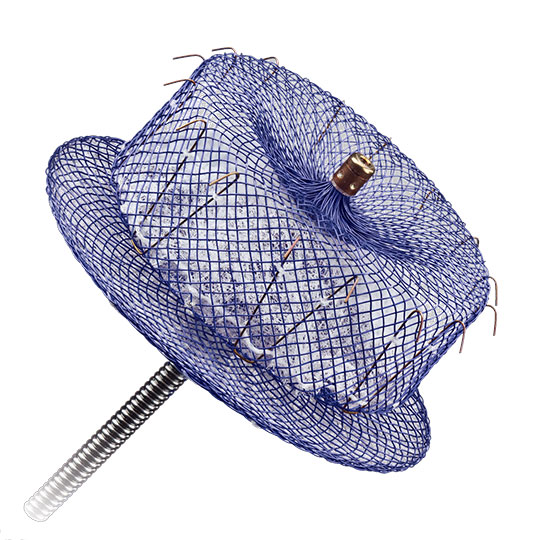Immediate Closure And Freedom1,2 From Oral Anticoagulants (OACs)
For patients with non-valvular atrial fibrillation, occlusion of the left atrial appendage (LAA) has been shown to reduce stroke risk.3 Amulet™ is the first and only FDA-approved LAA occluder to provide an immediate and complete ostial seal without requiring OACs at discharge.1

Ordering Information
Amplatzer™ Amulet™ LAA Occluder
| Reorder Number | Amulet Device Size/Lobe Diameter | Landing Zone Width (mm) | Lobe Length (mm) | Minimum Sheath Size (mm) | Minimum LAA Depth (mm) | Disc Diameter (mm) |
|---|---|---|---|---|---|---|
| 9‑ACP2‑007‑016 | 16 | 11.0-13.0 | 7.5 | 12 F | ≥ 10 | 22 |
| 9‑ACP2‑007‑018 | 18 | 13.0-15.0 | 7.5 | 12 F | ≥ 10 | 24 |
| 9‑ACP2‑007‑020 | 20 | 15.0-17.0 | 7.5 | 12 F | ≥ 10 | 26 |
| 9‑ACP2‑007‑022 | 22 | 17.0-19.0 | 7.5 | 12 F | ≥ 10 | 28 |
| 9‑ACP2‑010‑025 | 25 | 19.0-22.0 | 10 | 12 F | ≥ 12 | 32 |
| 9‑ACP2‑010‑028 | 28 | 22.0-25.0 | 10 | 14 F | ≥ 12 | 35 |
| 9‑ACP2‑010‑031 | 31 | 25.0-28.0 | 10 | 14 F | ≥ 12 | 38 |
| 9‑ACP2‑010‑034 | 34 | 28.0-31.0 | 10 | 14 F | ≥ 12 | 41 |
Contents: 1 each occluder, 145 cm delivery cable, plastic vise for delivery cable, hemostasis valve, loader, loading cable and plastic vise for loading cable, sheath adaptor (16 – 25 mm devices only).

Rx Only
Important Safety Information
AMPLATZER™ AMULET™ LEFT ATRIAL APPENDAGE OCCLUDER
Indication for Use
The Amplatzer™ Amulet™ Left Atrial Appendage Occluder is a percutaneous transcatheter device intended to reduce the risk of thrombus embolization from the left atrial appendage (LAA) in patients who have nonvalvular atrial fibrillation and who are at increased risk for stroke and systemic embolism based on CHADS2 or CHA2DS2- VASc scores, are suitable for short term anticoagulation therapy, and have appropriate rationale to seek a non- pharmacologic alternative to oral anticoagulation, taking into consideration the safety and effectiveness of the device.
Contraindications
The Amplatzer™ Amulet™ Left Atrial Appendage (LAA) Occluder is contraindicated for patients:
- With the presence of intracardiac thrombus.
- With active endocarditis or other infections producing bacteremia.
- Where placement of the device would interfere with any intracardiac or intravascular structures.
Potential Adverse Events
Potential adverse events associated with the device or implant procedure include, but are not limited to, the following: Air embolism; Airway trauma; Allergic reaction; Anemia; Anesthesia reaction (nausea, vasovagal reaction, confusion/altered mental status or other); Arrhythmia; Atrial septal defect; Bleeding; Cardiac arrest; Cardiac tamponade; Chest pain/discomfort; Congestive heart failure; Death; Device embolization; Device erosion; Device malfunction; Device malposition; Device migration; Device-related thrombus; Fever; Hematuria; Hypertension/hypotension; Infection; Multi-organ failure; Myocardial infarction; Perforation; Pericardial effusion; Pleural effusion; Renal failure/dysfunction; Respiratory failure; Seizure; Significant residual flow; Stroke; Thrombocytopenia; Thromboembolism: peripheral and pulmonary; Thrombus formation; Transient ischemic attack; Valvular regurgitation/insufficiency; Vascular access site injury (hematoma, pseudoaneurysm, arteriovenous fistula, groin pain or other); Vessel trauma/injury.
MAT-2111182 v2.0 | Item approved for U.S. use only.



